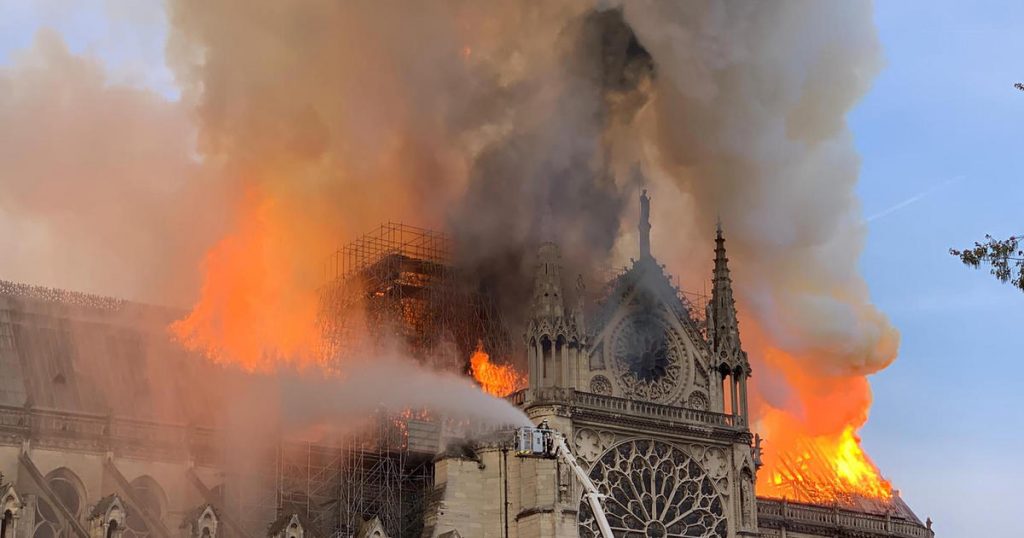Blog Post
Notre Dame’s burning spires force us all to face the truth about the West
By Jonathon Van Maren
With millions of others, I watched the sickening livestream yesterday of Notre Dame Cathedral ablaze in the centre of Paris. Just before it collapsed, the iconic spire was transformed into a flaming finger thrust upwards, belching smoke, and for a horrible moment it looked eerily like Tolkien’s Dark Tower of Barad-dûr. The crowd watched the inferno, most silent, some sobbing, one old man reaching towards the burning church helplessly. Later, young men and women knelt and sang and chanted as the heart of France crackled into ash. “Even if today’s disaster was simply the most freakish of accidents,” Douglas Murray mourned, “ours would still be the era that lost Notre Dame.”
It now appears that the two main bell towers and the main structure have been saved, and so perhaps Rod Dreher and others were blessedly wrong when they mourned that theirs was the last generation that would ever see the beauty of Notre Dame. I saw that most famous of the medieval cathedrals (built on the ruins of two earlier churches) only once, in 2006. Perhaps it will rise again as Macron has already promised, despite the fact that we seem to have lost the ability to create such beautiful things. Even if it does—and French billionaire Francois-Henri Pinault has already pledged 100 million euros towards that end—much of it is gone. The best news so far is that the stained glass windows, which last night were thought to have exploded with the heat, may have survived the blaze.
Like many others, the fiery images emitting from Paris made me think immediately of Victor Hugo. He was long a passionate lover of traditional architecture—several weeks ago I visited the home where he lived while an exile in Vianden, Luxembourg, where he championed the “sinister and magnificent ruin” of Vianden Castle. But Notre Dame was his muse, the “symphony in stone.” In his heart-wrenching but essential 1831 novel The Hunchback of Notre Dame, which I first read in my early teens, he describes it this way: “Every surface, every stone of this venerable pile is a page of history not only of the country, but of science and art. Thus—to mention here only a few of the chief details—whereas the small Porte Rouge almost touches the limits of the fifteenth century Gothic delicacy, the pillars of the nave, by their massiveness and great girth, reach back to the Carlovingian Abbey of Saint-Germain-des-Pres. One would imagine that six centuries lay between that door and those pillars.”
It was inevitable that the searing images of the cathedral wreathed in flames, resembling a red-hot burning cross from the sky above, would incur end-of-civilization metaphors. They began before the fire was out. “If you were waiting for a sign concerning the scope and seriousness of what must be rebuilt in our age, and what will happen if not, this is it,” observed James Poulos. “If someone was writing a novel about the collapse of Western civilisation, Notre Dame would burn at this stage,” wrote Nick O’Malley of the Sydney Morning Herald. And it is true. In the despairing faces of those who watched the spire crack and fall seemed to be a recognition that the modern European lacks the beliefs and the values that sent such towers soaring skyward centuries ago. Indeed, only 18% of Europeans who identify as Christian still even bother to attend church services. The great cathedrals are now only tourist attractions, museums of a bygone era.
In perhaps the most ironic of responses to the tragedy of 800 years of history going up in smoke, progressive commentator Ian Millhiser tweeted that, “The fact that a human achievement that took a century to build can be burnt away in a few hours is such a horrible metaphor for democracy in 2019.” And it takes a rootless progressive to look at a burning church and conclude that the politics of the current year are being symbolized there rather than the relentless smashing of our collective Judeo-Christian heritage by progressives like himself over the past century. It is the progressives that have played the role of iconoclast and demanded that we do away with the beliefs that gave rise to the awesome spires of Europe’s cathedrals, and it is they that have cheered the destruction and warmed themselves by the flames. What they have not realized is that once you start a fire, you cannot always control where it spreads and you may not have the power to put it out once it begins to consume things that you wanted to keep.
Many people have been expressing shock that the loss of a building of stone has drawn such an emotional reaction from so many. People found themselves moved in a way that they could not have predicted. I think the reason for this outpouring of emotion is that the loss of towering stone edifices that stood for centuries shakes us because we thought they would always be there. Generations come and go, but these monuments to Western Civilization stand guard over those who rise and fall in their shadows. And when we see Notre Dame go up in one last red and orange burst of awful beauty, we are forced to face the sickening truth: Nothing lasts forever. Not even Western Civilization.









Thank you for article. I thought the picture of the gold cross above the altar , in the post-fire pictures ‘ most apropos. Materials can be destroyed; the cross and its meaning “cannot”.
Great article!
Thanks Jonathon – great article